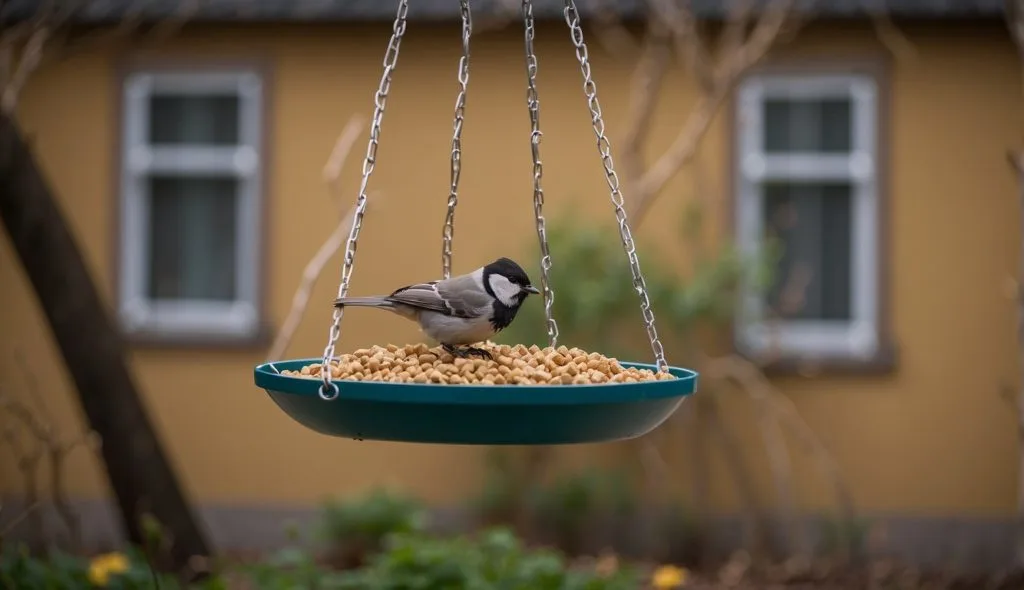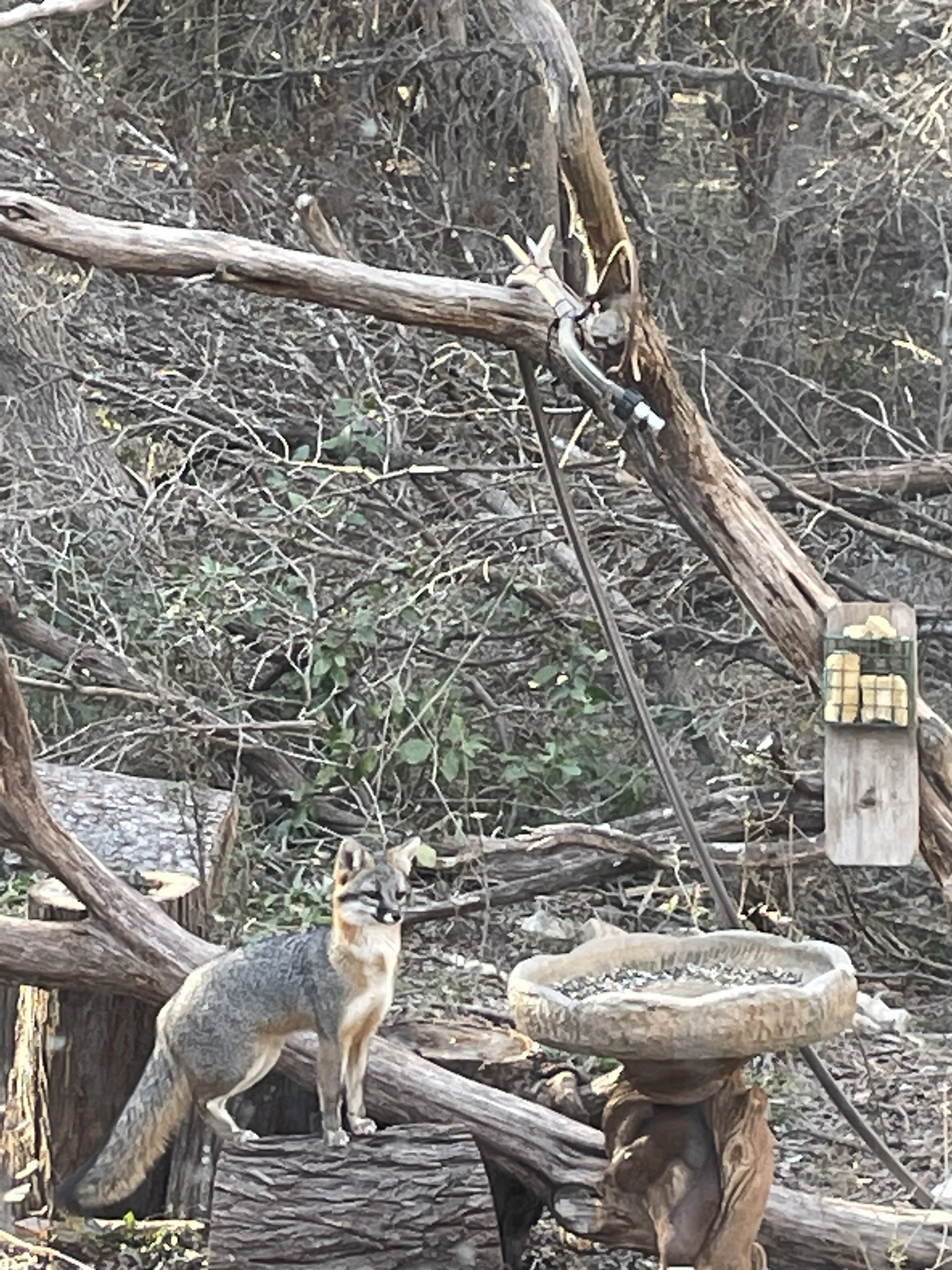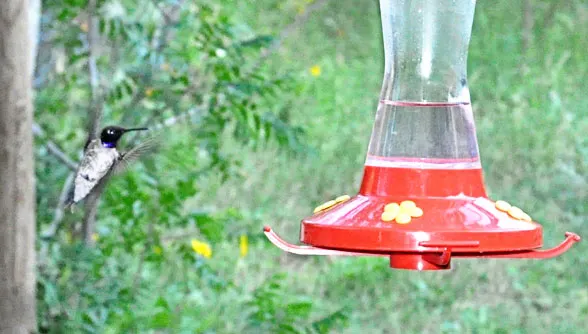Selecting the ideal location for a bird feeder is a balance between providing a safe feeding space for birds and ensuring an unobstructed view for your enjoyment. While you might want to place a bird feeder close to your home for better viewing, it’s important to consider the safety of the birds. Bird feeders placed too close to a house can increase the risk of birds flying into windows, leading to injury or death. Conversely, feeders set too far away may not deter predators and could make bird watching less accessible for you.

Key Takeaways
- Position bird feeders to minimize window collisions and deter predators.
- Consider visibility for birdwatching and safe distances from your home.
- Adjust feeder placement based on feeder type and yard characteristics.
Optimal Distance for Bird Feeders from the House
When positioning your bird feeder, it’s important to consider the safety of the birds and the prevention of nuisance animals. Finding the right spot ensures birds can feed securely and you can enjoy their presence without inconvenience.
Preventing Window Collisions
To reduce the risk of birds flying into windows, place your bird feeder either less than 3 feet away from your house or more than 30 feet away. This strategy is vital for their safety.
Close proximity allows little room to gain enough speed for a dangerous collision–birds don’t gain enough momentum to injure themselves if they hit the glass. Putting the feeder at least 30 feet away reduces the likelihood of the birds mistaking reflections in your windows for open sky.
Protection Against Predators
Your feeder should be in a location that thwarts predators such as feral cats and raccoons. Ideally, maintain a distance of at least 10-12 feet from shrubs or trees that predators could use for cover. A clear line of sight will assist birds in spotting any dangers while still offering them a quick escape to shelter if needed.
For deterring unwanted wildlife, a safety zone of about 50 feet may be effective, although this varies with the layout of your garden and local wildlife activity. Our bird feeding station is a distance away from the house but not far from the woods–so wildlife comes up, usually at night (when I’ve emptied the suet and any fruit feeders but when fallen seed is still on the ground) but sometimes in the daytime:

Preventing Squirrel and Rodent Access
Squirrels and rodents, like mice, see bird feeders as an easy food source. To discourage them, ensure the feeder has a 50 to 60-foot buffer from your house, minimizing the chances of these critters becoming uninvited guests in your home.
Utilize baffles and choose feeder designs that are more challenging for squirrels to maneuver.
How to Improve Your Visibility of the Feeders
Proper placement of your bird feeder enhances visibility for you, integrates seamlessly with your garden’s aesthetics, and provides accessibility for bird watching. This strategic positioning in your yard keeps the ecosystem vibrant and the bird activity high.
Promoting a Clear View and Easy Viewing
To maintain a clear view, place feeders in spots without visual obstructions. We also like to place feeders in view of windows that don’t have lots of traffic so we can observe natural bird behaviors without startling them.
Integration with Natural Landscaping
Incorporate the bird feeder into your natural landscaping to help birds feel safe. Use native plants and shrubs as natural shelter for the birds. This also makes your yard more inviting and a part of the local ecosystem.
- Natural Shelter: Plant shrubs or trees nearby to offer quick escape routes.
- Ecosystem: Cultivating native plants supports the health of local bird and butterfly populations.
Accessibility for Bird Watching
Ensure your feeder is easily accessible for maintenance and enjoyable bird watching. Install paths or stepping stones that provide a comfortable approach for you to refill feeders or clean them, without disturbing the birds too much–or risking a fall yourself on an icy day.
Types of Bird Feeders and Their Placement
When setting up bird feeders around your home, consider the different types and their optimal placements to ensure the safety and comfort of the visiting birds, as well as to enhance your bird-watching experience.
Hanging Bird Feeders
Hanging bird feeders are the most versatile and popular type. You can hang them from tree branches, poles, or hooks, ideally at least 6 feet off the ground to deter most ground predators and about 8-10 feet away from trees or structures to prevent squirrels from leaping onto them. Provide both shaded and sunlight spots to accommodate different bird preferences.
- Sunlight: Attracts birds that enjoy sunbathing, like finches and sparrows.
- Shaded: Preferred by species that enjoy protection, such as chickadees and grosbeaks.
Suet and Weight-Sensitive Feeders
Suet feeders typically cater to birds that prefer high-energy food like suet and are great for winter months. Install these around 5 feet high to deter ground predators and where they can receive partial sunlight. This prevents the suet from melting on warmer days but still gives birds access to warmth.
Ground Feeders and Protection
Though not hanging, ground feeders are excellent for ground-feeding birds like doves, juncos, and cardinals. Place these feeders in a clear area where you can observe the birds, but also provide nearby shelter for a quick escape from aerial and ground predators. It’s best to locate them about 10 feet away from dense bushes where cats or other predators could hide.
Factors Influencing Feeder Location
Selecting the best location for your bird feeder enhances the birds’ safety and your viewing pleasure. Contemplate sun exposure, weather conditions, and the feeder’s relationship to food and water sources to attract a greater variety of birds.
Sun and Shade Preferences

Birds have specific preferences for sun and shade. Depending on the species, they might prefer a shaded area to avoid overheating, especially during the hotter parts of the day.
A location that provides a balance of sunlight and shade throughout the day can cater to the diverse needs of visiting birds.
Hummingbird feeders are best hung in the shade to help keep the nectar cooler.
For instance, a feeder placed on the east side of your home may offer morning sunlight and afternoon shade, accommodating different species’ temporal feeding habits.
- Morning sun exposure is beneficial for drying dew from the feeder, keeping seeds dry.
- Afternoon shade can help to keep the feeder and birds cool in summer months.
Wind and Weather Considerations
Your bird feeder should be protected from wind to prevent spillage of seeds and to offer a stable feeding environment for birds. A location sheltered by a tree or shrub can serve as a windbreak, ensuring that the feeder isn’t swinging or tipping over during gusty weather.
- Position the feeder so it’s sheltered by nearby structures or natural windbreaks.
- Avoid open, exposed areas where strong winds could deter birds from visiting.
Proximity to Food Sources and Water
Birds are more likely to frequent a feeder that’s close to a bird bath or other water source, as well as natural food sources such as trees and shrubs that produce seeds and fruits.
- Ensure there’s a clean water source nearby, such as a bird bath, for the birds to drink and bathe.
- A feeder near berry-producing plants or seed-rich vegetation offers a supplementary food source, making your yard a one-stop-shop for bird sustenance.
- 8 Letter Bird Names - August 14, 2024
- 7 Letter Bird Names - August 14, 2024
- 7 Birds Named After Famous People - July 23, 2024
